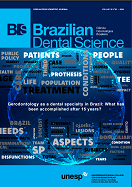Electromyographic activity in patient with an inferior implant/tooth-supported overdenture: Clinical Case Report.
DOI:
https://doi.org/10.14295/bds.2016.v19i2.1191Resumo
Clinicians can find patients with one mandibular remaining tooth, and it is difficult to decide if the tooth has to be removed. When a clinician decide to maintaining the tooth, it is common to feel doubts about masticatory load distribution divided between the tooth and implant. This paper reports a clinical case of patient with an implant/tooth-supported overdenture and elucidates the masticatory efficiency by electromyography activity analysis. The objective of this case report was to describe a clinical case of a patient with an implant/tooth-supported overdenture and to discuss the muscle response to this treatment. Electrical activities of the masseter and anterior temporal surfaces at maximum voluntary contraction were evaluated by electromyography during pre-treatment, immediately post-treatment, 15 and 60 days after installation. When patient has one remaining tooth in good condition, the implant/tooth-supported overdenture can be recommended, to preserve the periodontal ligament and proprioception, and to minimize bone loss. Electromyography analysis showed that implant/tooth-supported overdenture is a viable treatment alternative, in muscular standpoint, when the patient has a remaining tooth with good osseous support.
Downloads
Downloads
Arquivos adicionais
Publicado
Como Citar
Edição
Seção
Licença
TRANSFERÊNCIA DE DIREITOS AUTORAIS E DECLARAÇÃO DE RESPONSABILIDADE
Toda a propriedade de direitos autorais do artigo "____________________________________________________________________" é transferido do autor(es) para a CIÊNCIA ODONTOLÓGICA BRASILEIRA, no caso do trabalho ser publicado. O artigo não foi publicado em outro lugar e não foi submetido simultaneamente para publicação em outra revista.
Vimos por meio deste, atestar que trabalho é original e não apresenta dados manipulados, fraude ou plágio. Fizemos contribuição científica significativa para o estudo e estamos cientes dos dados apresentados e de acordo com a versão final do artigo. Assumimos total responsabilidade pelos aspectos éticos do estudo.
Este texto deve ser impresso e assinado por todos os autores. A versão digitalizada deverá ser apresentada como arquivo suplementar durante o processo de submissão.




























